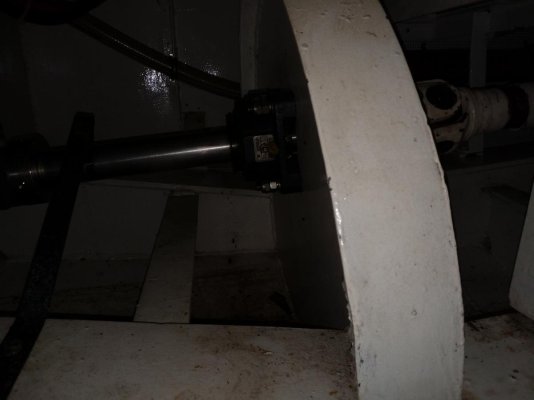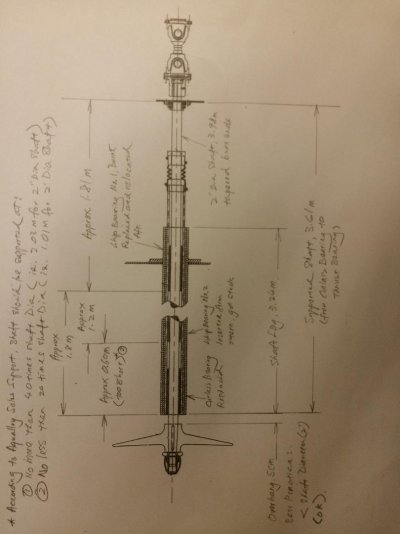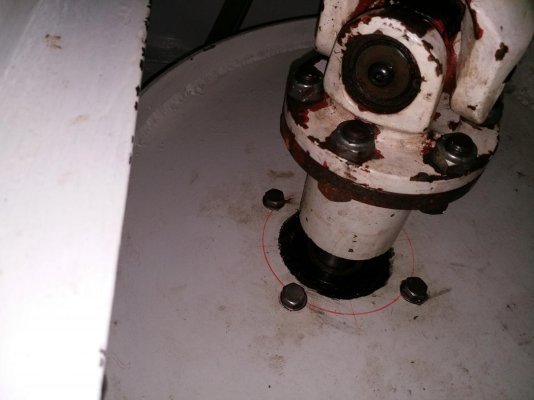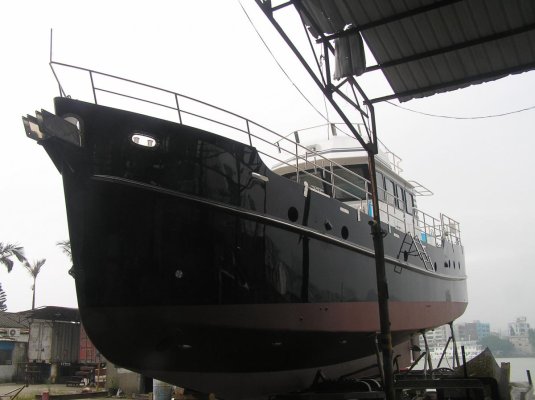SeahorseMarineDD54201
Veteran Member
I own a 55’ steel Diesel Duck (DD542) trawler yacht, which is a lengthened version of the very successful 48’ Diesel Duck (DD462) built by Seahorse Marine in Zhuhai, China (Zhuhai is a few hours from Hong Kong). The boat is now registered in Hong Kong since 2014.
DD542 is beautifully built like its DD462 cousin, except it vibrates.
Seahorse knew about the vibration then (unfortunately I did not), but chose to deliver the defective boat. Seahorse also knew the severe financial consequence of either bringing the boat back to the yard (a government policy was and still is in effect that the boat must be towed “$$” and must be bonded at 43% boat value”$$$$”), or fixing the problem by any Hong Kong yards (known for their outrageous charges). Seahorse (Bill Kimley) said the yard is at fault and will fix the problem.
Seahorse has by now tried all simple fixes in sub-contractor yards without success. The boat needs some serious trial and error troubleshooting while sitting in a yard for an extended period.
Bill Kimley and his wife Stella still contend that they are ready to fix the problem. However with all the expenses incurred already, Seahorse refuses to engage another sub-contractor yard. Bill and Stella also will not put in the the cash for bringing the boat back into Seahorse yard, blaming the government for its “crazy rules”. Unreasonable the policy maybe, the policy was known to Seahorse at the time of delivery. It boggles the mind and it is irresponsible of Bill, that he now turns around to blame the government.
Anyway I am now stuck with fixing the boat myself, if I do not want to wait for the government policy to change (I have been waiting for three and half years and there is no talk of new policy changes in this regard). I have very limited financial means, and cannot pay the bond and towage to go back to Seahorse yard. I need to fix the problem in Hong Kong, and I cannot afford any unnecessary trial and error. I hope this post brings me some advices from the community, how to be smart in going about this.
Here are some facts, questions, and plans:
1. Vibration increases with load (none in idle) regardless of forward or reverse. Vibration becomes unmistakably noticeable at 1200rpm and continue to increase with rpm. However at about 1900rpm vibration dampens down RELATIVELY; yet as rpm continue to rise to around 2200rpm (engine max out at 2500rpm), vibration not only is pronounced, it goes through cycles of peak and trough every few seconds, as if something is flexing then bouncing back.
2. Compared with the very successful DD462, DD542 has a longer shaft at 4 meters (about 31cm longer than DD462), at the same diameter of 2”. Seahorse (Bill Kimley) is adamant the shaft is not too thin (engine power is 178hp), and this claim seems to agree with calculations by reputable shaft suppliers.
3. However there is a concern where to place the whip bearing for such a long shaft, between the shaft exit Cutlass bearing, and the (forward) thrust bearing. Seahorse experimented with the location and has relocated to the presently just about at the middle of the shaft, about 1.8 meter from either the Cutlass bearing or the (forward) thrust bearing. So the shaft is on one end supported by a Thrust Bearing, the other end by the shaft exit Cutlass Bearing, and in the middle by a whip bearing. This should conform to the guideline of 40xdiameter (of shaft) which is 2 meters. But there is no improvement on vibration.
4. At this point engine, engine mount (anti-vibration), engine alignment, propeller type, propeller size, propeller clearance (cavitation), shaft straightness (checked when pulled out), whip bearing location have all been checked and tried. The latest attempt was to check if the 3 blade Max prop (feathering), new to Seahorse Diesel Ducks, was the cause. A smaller fixed 4 blade prop with more hull clearance, and generated maximum only 50+% power, was installed. If there is no vibration the plan was to then go for a 100% sized fixed 4 blade prop. The vibration became less, BUT STILL VERY evident despite the reduced loading. Incidentally Seahorse (Bill’s wife Stella) actually took this as an improvement. It boggles the mind again …
5. I contacted the late George Buehler who is the father of the wonderful Diesel Duck design. George told me about earlier Seahorse Diesel Ducks, and suggested me to buy a new name brand shaft. Based on what he saw with an earlier 55’ Diesel Duck built by Seahorse, the Chinese made shaft “could not hold shape”. The earlier 55’ had such a bad vibration that the coupling came off. The problem was completely fixed by the owner after delivery, by changing out the shaft and re-aligning the drive train.
6. Seahorse (Bill Kimley) disagreed with George on shaft material as an issue, despite known shaft quality problems with the earlier DD55 (and a couple of DD462s according to George). But I am willing to give it a try. Though the Chinese made shafts are shown to be adequate for DD462, but being longer they may not be enough for the lengthened DD542. The "cycling of vibration with peak and trough" mentioned in Point 1 suggests the shaft is flexing under load. Such a job would take a day or so in a Hong Kong yard if well planned. I can pay that expense and demand repayment from Seahorse.
7. I plan to install a proper name brand shaft and re-install the original 100% Max Prop. I ask for advices from the community, if anything else obvious I should account for with my limited financial means.
Thank you all in advance.
The owner of Seahorse Marine Diesel Duck DD542
DD542 is beautifully built like its DD462 cousin, except it vibrates.
Seahorse knew about the vibration then (unfortunately I did not), but chose to deliver the defective boat. Seahorse also knew the severe financial consequence of either bringing the boat back to the yard (a government policy was and still is in effect that the boat must be towed “$$” and must be bonded at 43% boat value”$$$$”), or fixing the problem by any Hong Kong yards (known for their outrageous charges). Seahorse (Bill Kimley) said the yard is at fault and will fix the problem.
Seahorse has by now tried all simple fixes in sub-contractor yards without success. The boat needs some serious trial and error troubleshooting while sitting in a yard for an extended period.
Bill Kimley and his wife Stella still contend that they are ready to fix the problem. However with all the expenses incurred already, Seahorse refuses to engage another sub-contractor yard. Bill and Stella also will not put in the the cash for bringing the boat back into Seahorse yard, blaming the government for its “crazy rules”. Unreasonable the policy maybe, the policy was known to Seahorse at the time of delivery. It boggles the mind and it is irresponsible of Bill, that he now turns around to blame the government.
Anyway I am now stuck with fixing the boat myself, if I do not want to wait for the government policy to change (I have been waiting for three and half years and there is no talk of new policy changes in this regard). I have very limited financial means, and cannot pay the bond and towage to go back to Seahorse yard. I need to fix the problem in Hong Kong, and I cannot afford any unnecessary trial and error. I hope this post brings me some advices from the community, how to be smart in going about this.
Here are some facts, questions, and plans:
1. Vibration increases with load (none in idle) regardless of forward or reverse. Vibration becomes unmistakably noticeable at 1200rpm and continue to increase with rpm. However at about 1900rpm vibration dampens down RELATIVELY; yet as rpm continue to rise to around 2200rpm (engine max out at 2500rpm), vibration not only is pronounced, it goes through cycles of peak and trough every few seconds, as if something is flexing then bouncing back.
2. Compared with the very successful DD462, DD542 has a longer shaft at 4 meters (about 31cm longer than DD462), at the same diameter of 2”. Seahorse (Bill Kimley) is adamant the shaft is not too thin (engine power is 178hp), and this claim seems to agree with calculations by reputable shaft suppliers.
3. However there is a concern where to place the whip bearing for such a long shaft, between the shaft exit Cutlass bearing, and the (forward) thrust bearing. Seahorse experimented with the location and has relocated to the presently just about at the middle of the shaft, about 1.8 meter from either the Cutlass bearing or the (forward) thrust bearing. So the shaft is on one end supported by a Thrust Bearing, the other end by the shaft exit Cutlass Bearing, and in the middle by a whip bearing. This should conform to the guideline of 40xdiameter (of shaft) which is 2 meters. But there is no improvement on vibration.
4. At this point engine, engine mount (anti-vibration), engine alignment, propeller type, propeller size, propeller clearance (cavitation), shaft straightness (checked when pulled out), whip bearing location have all been checked and tried. The latest attempt was to check if the 3 blade Max prop (feathering), new to Seahorse Diesel Ducks, was the cause. A smaller fixed 4 blade prop with more hull clearance, and generated maximum only 50+% power, was installed. If there is no vibration the plan was to then go for a 100% sized fixed 4 blade prop. The vibration became less, BUT STILL VERY evident despite the reduced loading. Incidentally Seahorse (Bill’s wife Stella) actually took this as an improvement. It boggles the mind again …
5. I contacted the late George Buehler who is the father of the wonderful Diesel Duck design. George told me about earlier Seahorse Diesel Ducks, and suggested me to buy a new name brand shaft. Based on what he saw with an earlier 55’ Diesel Duck built by Seahorse, the Chinese made shaft “could not hold shape”. The earlier 55’ had such a bad vibration that the coupling came off. The problem was completely fixed by the owner after delivery, by changing out the shaft and re-aligning the drive train.
6. Seahorse (Bill Kimley) disagreed with George on shaft material as an issue, despite known shaft quality problems with the earlier DD55 (and a couple of DD462s according to George). But I am willing to give it a try. Though the Chinese made shafts are shown to be adequate for DD462, but being longer they may not be enough for the lengthened DD542. The "cycling of vibration with peak and trough" mentioned in Point 1 suggests the shaft is flexing under load. Such a job would take a day or so in a Hong Kong yard if well planned. I can pay that expense and demand repayment from Seahorse.
7. I plan to install a proper name brand shaft and re-install the original 100% Max Prop. I ask for advices from the community, if anything else obvious I should account for with my limited financial means.
Thank you all in advance.
The owner of Seahorse Marine Diesel Duck DD542
Last edited:





